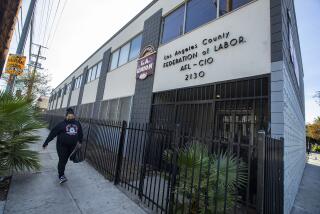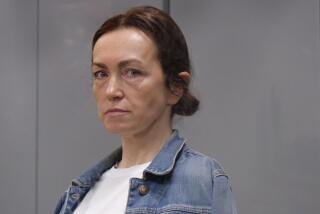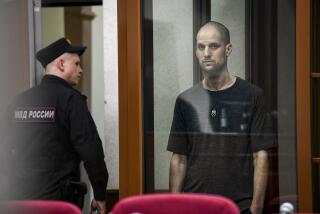Ruling on Miller’s Testimony a Blow to Defense in Spy Case
- Share via
Former FBI Agent Richard W. Miller, the government’s star witness in the trial of accused Soviet spies Svetlana and Nikolai Ogorodnikov, is expected to take the witness stand early this week to recount the events that led to his own arrest as the first FBI agent ever charged with espionage.
After six weeks of testimony in the sometimes slow-moving trial of the Ogorodnikovs, a Los Angeles federal judge set the stage for Miller’s testimony by ruling that prosecutors may ask Miller directly if he ever passed secret FBI documents to the Russian emigre couple.
The decision announced Friday by U.S. District Judge David V. Kenyon was a critical blow to defense hopes of preventing the jury from hearing some of the government’s most damaging evidence against the Ogorodnikovs.
While Miller’s attorneys have indicated that the former agent will deny passing any documents to the Ogorodnikovs, Kenyon’s decision permits the government to respond to any such denial by calling as witnesses the FBI agents who questioned Miller before his arrest last Oct. 2.
Miller, 48, a counterintelligence agent who became involved with the Ogorodnikovs in May, 1984, was questioned by FBI agents for five days before his arrest. He first denied passing any documents to the couple but later admitted he did so, according to the FBI.
Brad D. Brian, a defense lawyer for Svetlana Ogorodnikova, had urged Kenyon not to permit the government to impeach Miller’s statements with the testimony of the FBI agents. He claimed that such an action would be a subterfuge to present otherwise inadmissible hearsay evidence about the Ogorodnikovs to the jury.
Angered at Decision
When Kenyon announced his ruling out of the jury’s presence, Brian slammed a legal note pad on his desk and sat back with his head in his arms. Government prosecutors, who were worried that the decision might go against them, reacted with jubilation and spent the weekend preparing for a tough examination of Miller.
The judge’s ruling was just one of several setbacks for the Ogorodnikovs in a week that saw the government present some of its most crucial evidence against the two accused spies and Miller, who faces his own trial as an accused spy later this summer at the conclusion of the Ogorodnikovs’ trial.
Bruce G. Merritt and Richard B. Kendall, the two assistant U.S. attorneys prosecuting the case, called more than a dozen FBI surveillance agents in a continuing account of almost every move the Ogorodnikovs and Miller made during the monthlong investigation that preceded their arrests.
Last week’s testimony also focused on Aleksandr Grishin, identified by the FBI as a Soviet intelligence officer serving as a vice consul of the Soviet Consulate in San Francisco. He has been named as an unindicted co-conspirator in the alleged effort to recruit Miller as a paid agent of the Soviet Union. Grishin could not be charged in the case because he has diplomatic immunity.
Richard Otstott, coordinator of a special group of civilian FBI employees who routinely monitor the activities of Soviet officials in San Francisco, described an elaborate surveillance operation that focused on Grishin after FBI officials had concluded that he was the unknown Soviet official who was in telephone contact with Svetlana Ogorodnikova.
Couriers Followed
Every other Tuesday, Otstott said, the Soviet Consulate in San Francisco sends a van to the San Francisco Airport to meet Soviet couriers from the Soviet Embassy in Washington arriving on a regular TWA flight with diplomatic mail and other communications. They are followed by members of Otstott’s surveillance team, who make no effort to hide the fact that they are following the Soviets, Otstott said.
Last Sept. 25, however, there was a change in the usual Tuesday night scenario, he said, as Grishin joined the pair of Soviet officials assigned to meet the TWA flight. Following Grishin, along with the regular FBI surveillance team operating openly, were 20 other counterintelligence agents tailing him “discreetly” and waiting for him to make an effort to elude his more obvious followers.
Otstott said he waited outside the South Terminal of the San Francisco Airport as the Soviets arrived. When Grishin “peeled off” from the other Russians and headed down an escalator, Otstott followed him. Trailing him at a distance, the FBI agent lost sight of Grishin briefly, but then spotted him at 7:30 p.m. at a phone booth in a remote area of the terminal.
At that same minute, in Los Angeles, FBI counterintelligence Agent Michael di Pretoro was listening on an FBI wiretap to a telephone conversation between Svetlana Ogorodnikova and a Russian caller who had not yet been positively identified.
Grishin Identified
As a result of the surveillance in San Francisco, Grishin was identified as the caller. He was speaking that night to Ogorodnikova of plans for an airplane flight. The conversation, played to the jury, was in “plain talk code” and in Russian, di Pretoro testified.
The taped conversation included the following exchange:
“Svetlana, listen to me closely,” Grishin said. “Have you made an arrangement with the acquaintances?”
“Yes,” she said.
“You can fly out on the 10th then, right?”
“Yes,” she answered.
“They will be waiting for you on the 10th to set up your vacation and everything,” Grishin added.
Di Pretoro, interpreting the conversation, said that Grishin and Ogorodnikova were discussing plans for her and Miller to fly from Los Angeles to Vienna in early October. From there, the government claims, the two were to be taken to Warsaw, where Miller was to meet with Soviet intelligence officials.
Since his arrest, Miller has claimed that he was involved with the Ogorodnikovs to help the FBI as a counterintelligence agent. While Ogorodnikov has claimed to be innocent of any intrigue, his wife’s primary defense has been that she thought she was helping the FBI and was just going along with Miller’s efforts to help the United States infiltrate Soviet espionage activities.
On Sept. 26, Miller and Ogorodnikova--who had become sexually involved almost immediately after their first meeting four months earlier--were driving together in Ogorodnikova’s car, doing some shopping in anticipation of the trip to Europe. She had purchased a pair of wine-colored Italian shoes for Miller, and they also put a hold on a Size 50 Burberry’s trench coat for Miller after stopping at a clothing store in Westwood.
Last Sept. 4, the FBI installed telephone wiretaps in the Hollywood apartment of the Ogorodnikovs and in Miller’s homes in Lynwood and Valley Center in San Diego County. Eight days later, a tape recorder was also installed in Miller’s car. But in most of their meetings, the two suspected spies used Ogorodnikova’s car. The FBI did not have a chance to bug it electronically until Sept. 25.
Tape Considered Damaging
On Sept. 26, a tiny tape recorder planted in Ogorodnikova’s car was operating as she and Miller went shopping. Their hourlong conversation, played in full to the jury, was viewed by the government as particularly damaging to Ogorodnikova’s claims that she thought Miller was acting on behalf of the United States in his official capacity as a counterintelligence agent.
During the ride, Miller discussed the planned trip to Europe, saying he would use some of his FBI vacation time to explain his absence from the office. The government contends that Ogorodnikova would have questioned the need to take vacation time if she really believed Miller was acting for the FBI.
Miller, who is expected by the government to be a hostile witness, must testify in the Ogorodnikovs’ trial or risk a contempt citation. But he will receive immunity for his testimony so that it can not be used against him in his own trial. He is expected to take the witness stand either Tuesday afternoon or Wednesday.
More to Read
Sign up for Essential California
The most important California stories and recommendations in your inbox every morning.
You may occasionally receive promotional content from the Los Angeles Times.









